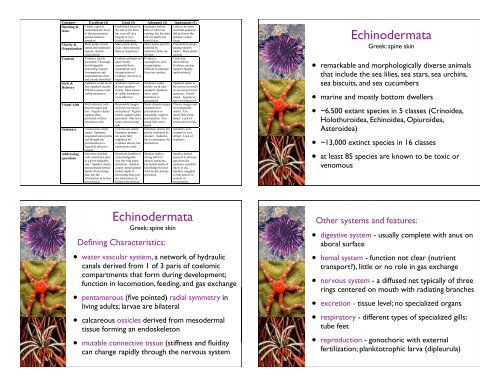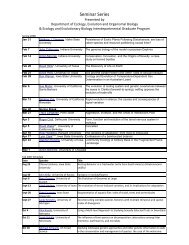Echinodermata Echinodermata
Echinodermata Echinodermata
Echinodermata Echinodermata
You also want an ePaper? Increase the reach of your titles
YUMPU automatically turns print PDFs into web optimized ePapers that Google loves.
Rubric for evaluating NEWS REPORTS, EOSC 310<br />
Use this rubric as a guide. Write the categories (left side) on your index card. Evaluate each category on a<br />
scale of 0-4. Write comments on reverse side of card.<br />
Category Excellent (4) Good (3) Adequate (2) Inadequate (1)<br />
Opening &<br />
intro<br />
Clearly, quickly<br />
established the focus<br />
of the presentation,<br />
gained audience<br />
attention<br />
Established focus by<br />
the end of the intro,<br />
but went off on a<br />
tangent or two.<br />
Audience had an<br />
idea of what was<br />
coming, but the intro<br />
did not clarify the<br />
Little or no intro,<br />
such that audience<br />
did not know the<br />
speaker’s main<br />
Gained attention. main focus. focus.<br />
Clarity & Main points clearly Main points fairly Main points must be Presentation jumps<br />
Organization stated and explained;<br />
logical, smooth<br />
clear; some missing<br />
links or transitions.<br />
inferred by<br />
audience; holes are<br />
among random<br />
topics. Main points<br />
organization<br />
evident.<br />
unclear<br />
Content Evidence clearly Evidence perhaps not Evidence,<br />
Lacks key<br />
presented. Thorough, quite clearly assumptions, and observations.<br />
knowledgeable separated from interpretation Evidence unclear.<br />
interesting, logical. assumptions and difficult to untangle Appears largely<br />
Assumptions and interpretation of from one another. opinion-based.<br />
interpretations clear, evidence, but story is<br />
and clearly identified. logical.<br />
Style & Audience could see & Audience could see Audience could Speakers spoke to<br />
Delivery hear speakers clearly.<br />
Effective pauses and<br />
& hear speakers<br />
clearly, Most pauses<br />
mostly see & hear<br />
speakers. Speakers<br />
the screen or mostly<br />
to one person in the<br />
verbal intonation. & verbal intonation show some audience. Poorly<br />
were effective. hesitation or timed. Appears to<br />
uncertainty. have not practiced.<br />
Visual Aids Well-selected, well- Reasonable images Some chosen images Chosen images and<br />
placed images and and text, not always extraneous to text marginally<br />
text. Figures clearly well-placed. Figures presentation or useful. Too<br />
support ideas clearly support ideas marginally support much/little extra<br />
presented without presented. May have presentation. Too detail. Lack of<br />
extraneous info. some extra/missing much/little extra connection to topic.<br />
info<br />
detail.<br />
Summary Conclusions clearly Conclusions stated. Summary shown but Summary non-<br />
stated. Summary Summary perhaps poorly explained by existent or very<br />
integrated main points not quite fully speaker. Audience abrupt. Lack of<br />
and brought the supported by has to summarize for synthesis.<br />
presentation to a evidence shown, but themselves.<br />
logical & effective<br />
closure<br />
main points clear.<br />
Addressing Questions handled Questions handled in Speaker made a Speaker lacked<br />
questions with confidence and<br />
in a knowledgeable<br />
a knowledgeable<br />
way but with some<br />
strong effort to<br />
answer questions,<br />
answers to obvious<br />
questions the<br />
way. Speaker clearly hesitation. Speaker but lacked depth of audience would be<br />
demonstrated further clearly demonstrated knowledge beyond likely to ask.<br />
depth of knowledge further depth of what he/she already Speaker struggled<br />
than just the<br />
knowledge than just presented.<br />
to link answer to<br />
information in his/her the information in<br />
content of<br />
presentation. his/her presentation.<br />
presentation.<br />
<strong>Echinodermata</strong><br />
Greek: spine skin<br />
Defining Characteristics:<br />
• water vascular system, a network of hydraulic<br />
canals derived from 1 of 3 paris of coelomic<br />
compartments that form during development;<br />
function in locomotion, feeding, and gas exchange<br />
• pentamerous (five pointed) radial symmetry in<br />
living adults; larvae are bilateral<br />
• calcareous ossicles derived from mesodermal<br />
tissue forming an endoskeleton<br />
• mutable connective tissue (stiffness and fluidity<br />
can change rapidly through the nervous system<br />
<strong>Echinodermata</strong><br />
Greek: spine skin<br />
• remarkable and morphologically diverse animals<br />
that include the sea lilies, sea stars, sea urchins,<br />
sea biscuits, and sea cucumbers<br />
• marine and mostly bottom dwellers<br />
• ~6,500 extant species in 5 classes (Crinoidea,<br />
Holothuroidea, Echinoidea, Opiuroidea,<br />
Asteroidea)<br />
• ~13,000 extinct species in 16 classes<br />
• at least 85 species are known to be toxic or<br />
venomous<br />
Other systems and features:<br />
• digestive system - usually complete with anus on<br />
aboral surface<br />
• hemal system - function not clear (nutrient<br />
transport?), little or no role in gas exchange<br />
• nervous system - a diffused net typically of three<br />
rings centered on mouth with radiating branches<br />
• excretion - tissue level; no specialized organs<br />
• respiratory - different types of specialized gills;<br />
tube feet<br />
• reproduction - gonochoric with external<br />
fertilization; planktotrophic larva (dipleurula)
Class Asteroidea (sea stars)<br />
• star-shaped, free moving, pentamerous animals<br />
• hollow arms project from a central disc<br />
• range from 2 cm to ~1 m in diameter<br />
• occur worldwide, largely in coastal waters<br />
• ~ 1500 species<br />
Asteroidea<br />
Water-Vascular System<br />
• consists of the hydraulic tube feet and internal coelomatic canals<br />
• canals: circumoral ring canal, radial canals, lateral canals, stone canal<br />
(opens aborally into a small chamber, madreporic ampulla, which joins the<br />
madreporite)<br />
• the WVS is lined by a myoepithelim and thus is ciliated and muscular<br />
Class Asteroidea (sea stars)<br />
• the mouth is located centrally on the underside of the disc (oral<br />
surface)<br />
• a large furrow (ambulacrum) extends radially from the mouth along<br />
each arm<br />
• each ambulacrum contains two or four rows of tube feet<br />
• the upper (aboral) surface bears an anus (when present) and a large,<br />
button-like madreporite (a sieve plae)<br />
Asteroidea<br />
Water-Vascular System<br />
Ampulla<br />
Ossicle<br />
Tube foot<br />
Sucker<br />
• each lateral canal has a valve and terminates in an ampulla and a tube<br />
foot (x40,000!)<br />
• the ambulacral ossicles form the floor of the ambulacral groove<br />
• longitudinal muscles of the ampulla contract => foot’s extension +<br />
attachment => longitudinal muscles of the foot contract => pulling<br />
force => detachment<br />
• adhesion is largely chemical, but adhesion by suction may also occur
Asteroidea<br />
Water-Vascular System<br />
• each lateral canal has a valve and terminates in an ampulla and a tube<br />
foot<br />
• the ambulacral ossicles form the floor of the ambulacral groove<br />
• longitudinal muscles of the ampulla contract => foot’s extension +<br />
attachment => longitudinal muscles of the foot contract => pulling<br />
force => detachment<br />
• adhesion is largely chemical, but adhesion by suction may also occur<br />
Asteroidea<br />
Digestive system<br />
• most of the space in the disc and arms is occupied by digestive system<br />
• the mouth opens into a short esophagus that leads to a large stomach<br />
• the stomach is divided by a horizontal constriction into a large, oral<br />
cardiac stomach and a smaller aboral pyloric stomach<br />
• pyloric stomach receives ducts from a pair of pyloric ceca in each arm<br />
• pyloric seca are elongate, hollow, branched extensions of the stomach<br />
Radial canal<br />
Tube foot<br />
Perivisceral<br />
coelom<br />
Pyloric cecum<br />
Pyloric stomach<br />
Anus<br />
Mouth<br />
Ring canal<br />
Cardial stomach
Asteroidea<br />
Nervous system<br />
• the peripheral nervous system includes two intraepithelial nets,<br />
the sensory ectoneural system in the epidermis and the motor<br />
hyponeural system in the coelomic lining<br />
• the CNS consists of ectoneural and hyponeural circumoral<br />
nerve rings and radial nerves<br />
• The motor component of the radial nerve innervates the<br />
ampullae, tube feet, and body-wall muscles, while the sensory<br />
part receives input from the sense cells and organs<br />
• no ganglia, no glea<br />
Asteroidea<br />
Hemal system<br />
• three interjoined radial sets of<br />
vessels, each consisting of a hemal<br />
ring around the gut and five<br />
sometimes branched radial vessels<br />
• the hyponeural hemal ring, the<br />
gastric hemal ring, and the genital<br />
hemal ring<br />
• Two specialized vessels called<br />
gastric hemal tufts cross the<br />
perivisceral coelom and unite the<br />
gastric hemal ring with the axial<br />
hemal vessel and heart<br />
• the three hemal rings are united<br />
by the vertical axial hemal vessel<br />
(axial gland) that lies in the wall of<br />
the axial canal<br />
Ectoneural<br />
nerve net<br />
Hyponeural<br />
nerve net
3 Bilateral symmetry<br />
Anteroposterior body organization<br />
Medial nerve cord<br />
Gut and CNS parallel<br />
Complex life cycle with larva<br />
Ciliated band in larva<br />
b<br />
1 Brachiolar complex (larva)<br />
2 Rudiment ectoderm invaginates<br />
3 Cilated band rearranged in larva<br />
4 Radial symmetry<br />
Loss of cephalization and brain?<br />
Radial nerve cords<br />
Gut and CNS orthogonal<br />
Water vascular system with podia<br />
Calcareous endoskeleton<br />
Metazoa<br />
Regeneration and clonal reproduction<br />
Larvae<br />
Adults<br />
feather stars sea stars brittle stars sea urchins sea cucumbers<br />
Morphology<br />
(Crinoidea) (Asteroidea) (Ophiuroidea) (Echinoidea)<br />
Genes : sites of expression<br />
Asterozoa<br />
Echinodermat<br />
Eleutherozoa<br />
ry history of body architecture and regulatory genes within the<br />
hinodermata (b). Reconstructed changes in morphology (left)<br />
mental roles and expression domains of regulatory genes<br />
he expression domains and roles of several regulatory genes<br />
ropods and chordates (a, 8) 8–11 , despite their phylogenetic<br />
orphological disparity 2,5,6 . These similarities probably reflect<br />
architectural features, such as bilateral symmetry and an<br />
is (a, 3) between protostomes and deuterostomes. Morpholo-<br />
istinguish phyla (such as a,1) and groups of related phyla( a, 2)<br />
ome such cases, changes in the developmental roles of<br />
, 5 and 7) have been identified that may have been involved<br />
e derived structures 9,10,17 . The origin of echinoderms followed<br />
rthropods and chordates, and involved substantive modifica-<br />
?<br />
Echinozo<br />
Sexual reproduction and<br />
development<br />
7 Hox cluster domains along A/P axis<br />
distal-less anterior CNS<br />
engrailed ganglia along CNS<br />
orthodenticle<br />
8 Hox genes domains along A/P axis<br />
5 orthodenticle ciliated band (larva)<br />
6 engrailed rudiment invagination<br />
7 distal-less brachiolar arms (larva)<br />
distal-les subtrochal cells (larva<br />
8 engrailed ectoderm<br />
(skeletogenesis)<br />
orthodenticle podia<br />
distal-les podia<br />
tions in basic body architecture (b, 2) 1–6 ; already present was a complex life cycle<br />
involving a larva that fed using a ciliated band (a, 3) 1–6 . Data reported here and<br />
taken from the literature 8–11,19 allow us to reconstruct changes in the expression<br />
domains of three regulatory genes during the origin and radiation of echino-<br />
derms. Several derived features of gene expression are shared by asterozoan<br />
and echinozoan echinoderm species (b, 7), implying that they were present<br />
before the divergence of these clades over 490 Myr ago 22 . The origin of these<br />
features could be even earlier (arrow near base of cladogram), but expression<br />
data are currently unavailable for crinoids, the most basal clade of extant<br />
echinoderms. Other features of gene expression appear to be limited to a<br />
single class (such as b, 4 and 6), suggesting later origins or subsequent losses<br />
within other lineages. Phylogenetic relationships are from refs 2, 6, 7 and 14.<br />
Egg Embryo Early larva Late larva Juvenile<br />
bilaterally symmetrical<br />
of echinoderm development. Echinoderm embryos and larvae<br />
etrical 1,6,16 . In late larvae, discrete populations of ectodermal<br />
cells on the left side of the body proliferate to form the<br />
ent (green crescent). The first radially symmetrical structures<br />
udiment (disc near late larva). During metamorphosis, many<br />
left-right asymmetrical<br />
radially symmetrical<br />
Echinoderm embryos and larvae are bilaterally symmetrical. In<br />
late larvae, discrete populations of cells on the left side of the<br />
body proliferate to form the imaginal adult rudiment. During<br />
metamorphosis, the rudiment gives rise to much of the radially<br />
metamorphosis.<br />
symmetrical juvenile (green).<br />
Lowe and Wray, 1997 Nature<br />
larval tissues (blue) are lost, and the rudiment gives rise to much of the juvenile<br />
(green). Domains of regulatory gene expression fall into three distinct symmetry<br />
classes: bilateral in embryos and early larvae; left–right asymmetric in late larvae,<br />
during establishment of the imaginal rudiment; and radial during and after<br />
Nature © Macmillan Publishers Ltd 1997<br />
6 OCTOBER 1997 719<br />
Sexual reproduction and<br />
development<br />
• Asteroids are typically gonochorists with<br />
external fertilization and a complex life cycle<br />
that includes a planktotrophic larva<br />
• Up to 2,500,000 eggs<br />
• Development includes radial cleavage,<br />
regulative development, and enterocoelous<br />
origin of the coelomic cavities<br />
• The bilaterally symmetric, suspensionfeeding<br />
larva (bipinnaria -> brachiolaria)<br />
Class Crinoidea<br />
crown<br />
stalk<br />
• The main part of the body is supported above the substrate<br />
either by a long stalk or by a series of grasping claws (cirri)<br />
• suspension feeders with mouth oriented upward<br />
• feather starts and sea lilies (~700 species)<br />
cirri
Class Echinoidea [“spine-like”]<br />
• Lack arms; the ambulacra and oral surface expanded aborally to cover<br />
most of the body<br />
• ossicles are joint to form a rigid test (like a shell but internal)<br />
• podia pores pass through the ambulacral plates<br />
• adults generally possess an Aristotle’s lantern - a complex system of<br />
ossicles and muscles used for grazing and chewing<br />
• ~1000 species<br />
Class Ophiuroidea [“snake-like”] (Brittle stars)<br />
• Well-developed ossicles in the arms form a linear series of articulating<br />
“vertebrae” joined together by connective tissue and muscles<br />
• the oral surface bears 5 pair of invaginations (bursal slits), which may serve<br />
for gas exchange and as brood chambers for embryos<br />
• ~2100 species<br />
Class Holothurioidea (sea cucumbers)<br />
buccal podia<br />
• The body is worm-shaped, elongated along the oral/aboral axis<br />
• approximately one-third of species live in the deep sea, where they account<br />
for up to 90% of benthic biomas<br />
• the calcareous ossicles are reduced in size and embedded in the body wall<br />
• highly branched, muscular respiratory structures extend from the cloaca<br />
into the coelomatic cavity (respiratory tree)<br />
• ~1200 species
NATURE | VOL 392 | 5 MARCH 1998<br />
b<br />
Ciliated band in larva<br />
1 Brachiolar complex (larva)<br />
Larvae<br />
Adults<br />
feather stars sea stars brittle stars sea urchins sea cucumbers<br />
Morphology<br />
(Crinoidea) (Asteroidea) (Ophiuroidea) (Echinoidea) (Holothuroidea)<br />
Genes : sit<br />
2 Rudiment ectoderm invaginates<br />
3 Cilated band rearranged in larva<br />
4 Radial symmetry<br />
Loss of cephalization and brain?<br />
Radial nerve cords<br />
Gut and CNS orthogonal<br />
Water vascular system with podia<br />
Calcareous endoskeleton<br />
Asterozoa<br />
<strong>Echinodermata</strong><br />
Lowe and Wray, 1997 Nature<br />
Eleutherozoa<br />
?<br />
Echinozoa<br />
Eleuterozoa<br />
Nature © Macmillan Publishers Ltd 1998<br />
Echinozoa<br />
Cryptosyringida<br />
8 Hox genes do<br />
5 orthodenticle<br />
6 distal-less<br />
7 distal-less<br />
distal-less<br />
8 engrailed<br />
orthodenticle<br />
distal-less





